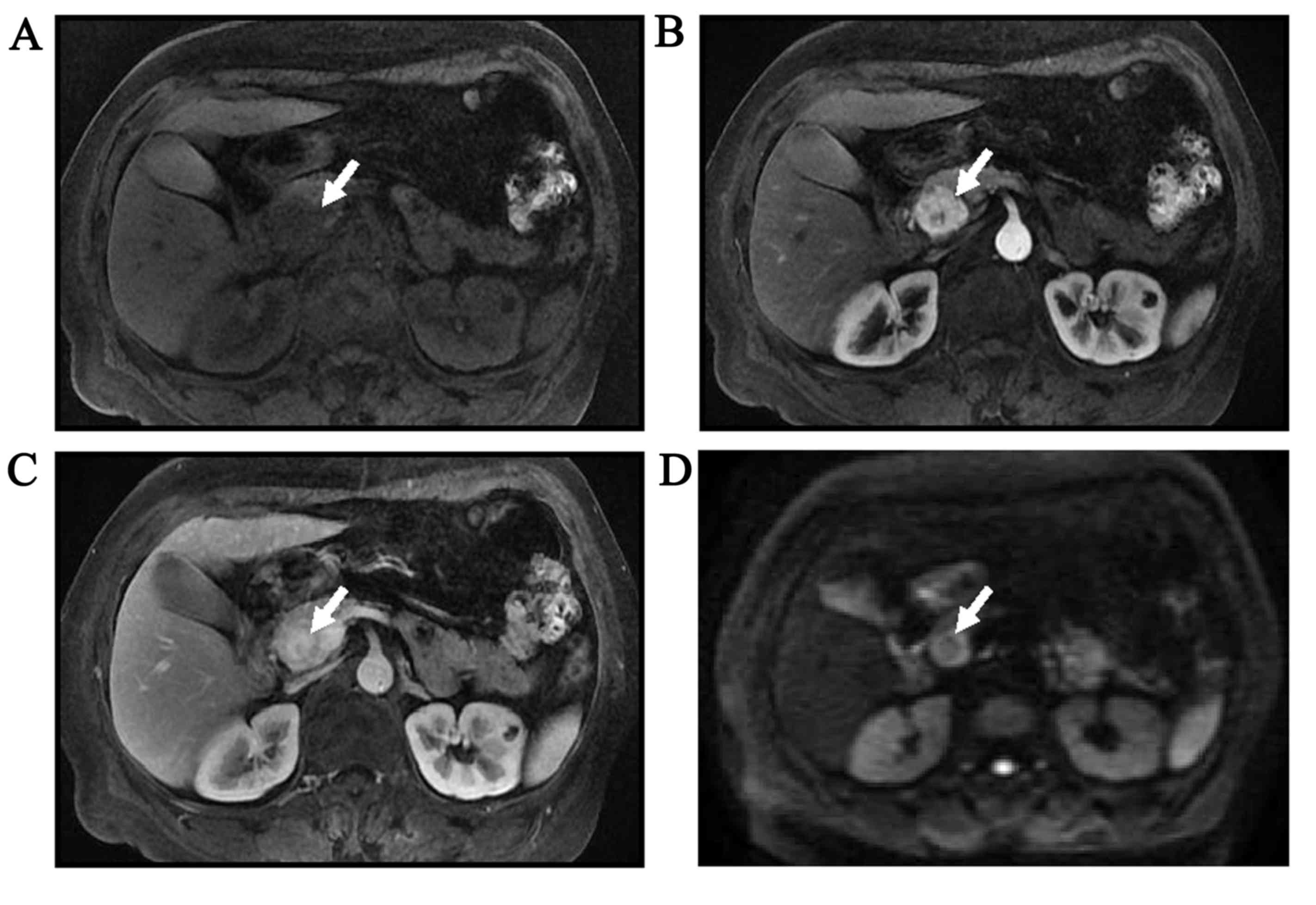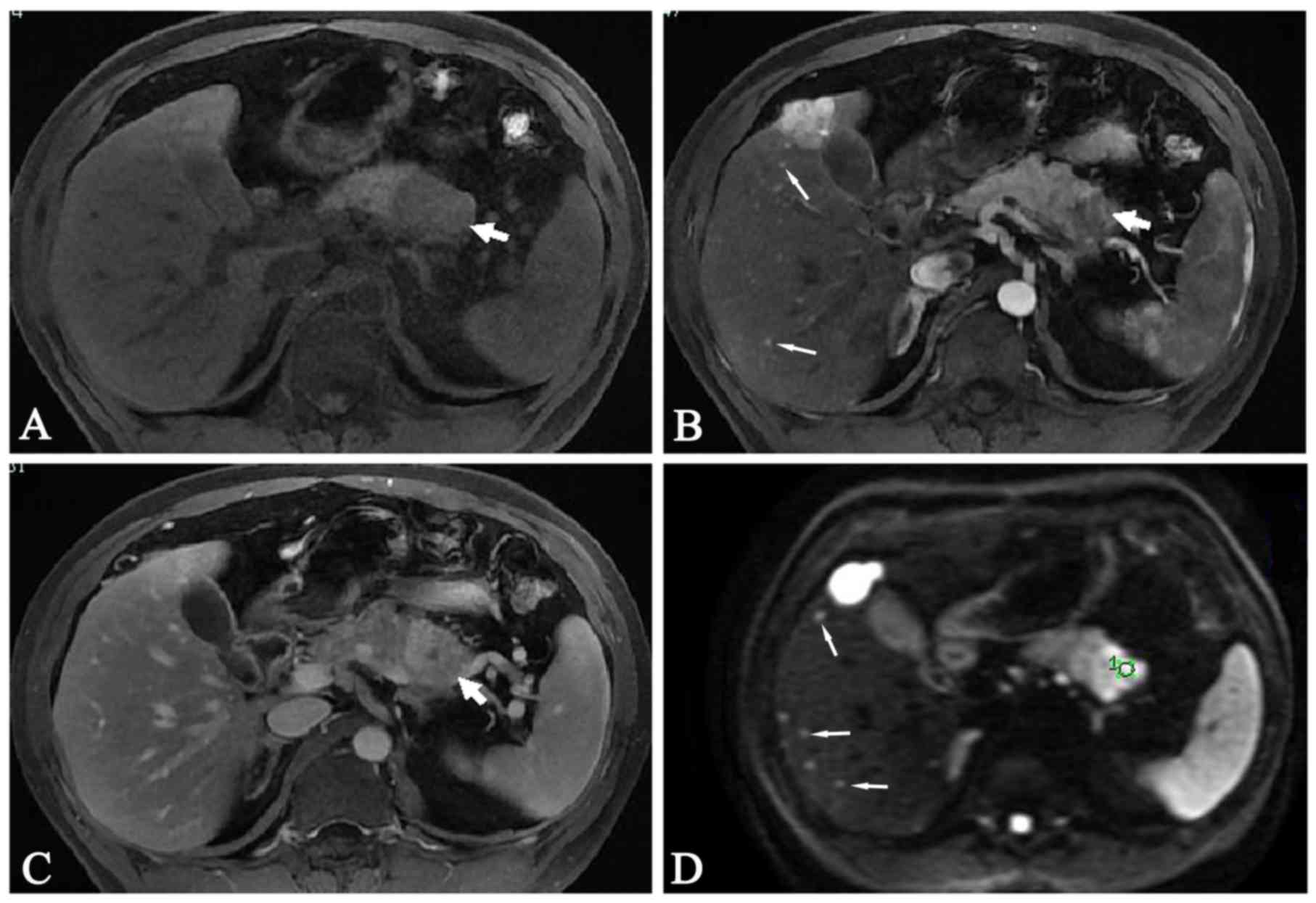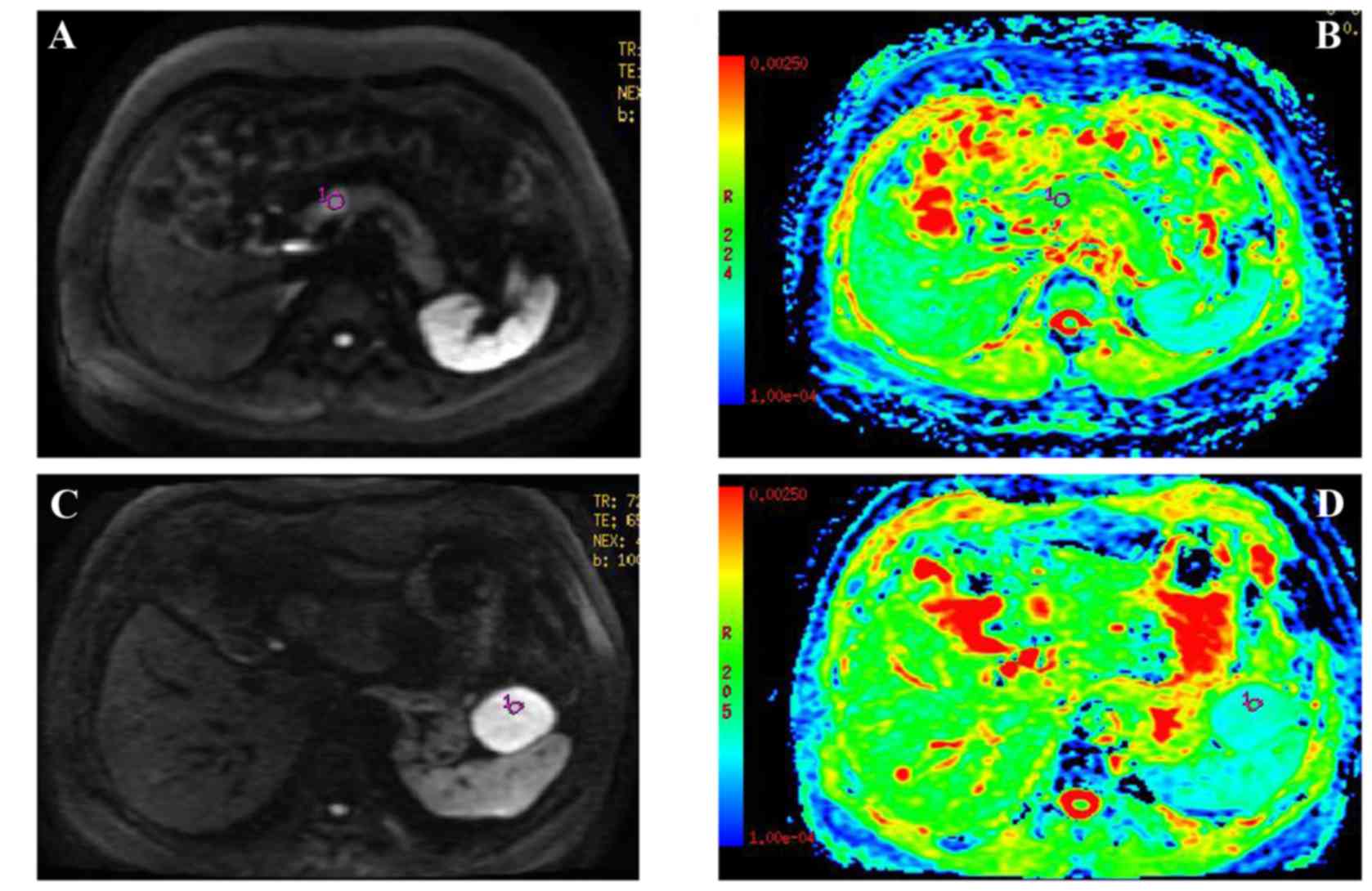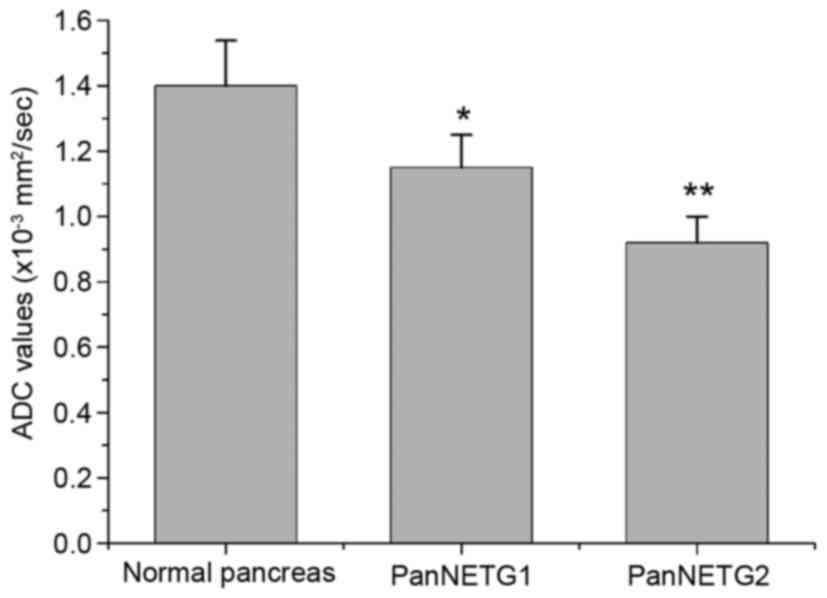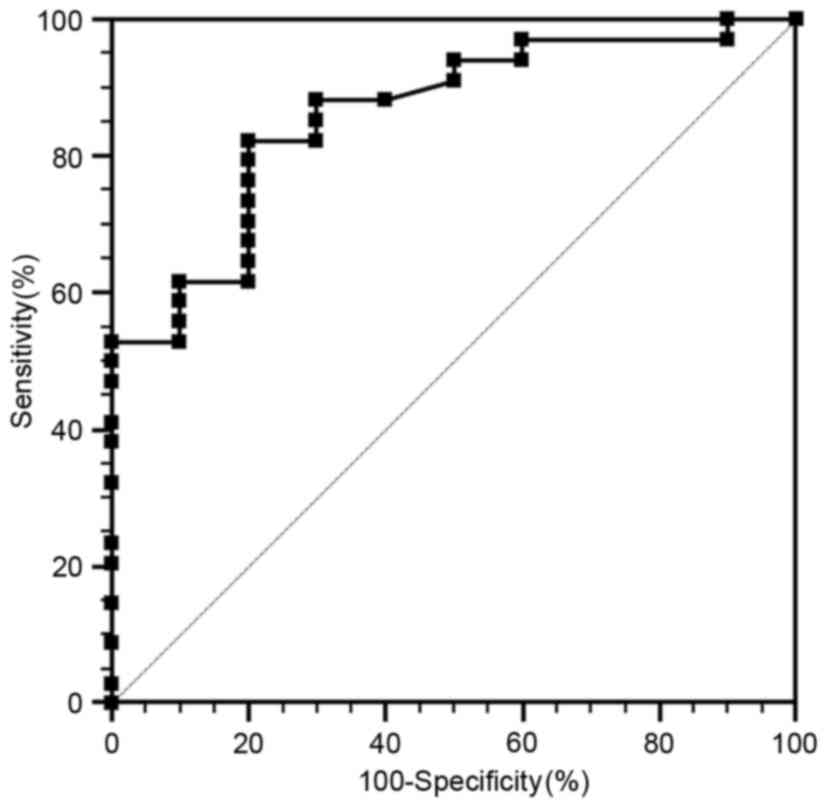|
1
|
Wang Y, Miller FH, Chen ZE, Merrick L,
Mortele KJ, Hoff FL, Hammond NA, Yaghmai V and Nikolaidis P:
Diffusion-weighted MR imaging of solid and cystic lesions of the
pancreas. Radiographics. 31:E47–E64. 2011. View Article : Google Scholar : PubMed/NCBI
|
|
2
|
Kim JH, Eun HW, Kim YJ, Han JK and Choi
BI: Staging accuracy of MR for pancreatic neuroendocrine tumor and
imaging findings according to the tumor grade. Abdom Imaging.
38:1106–1114. 2013. View Article : Google Scholar : PubMed/NCBI
|
|
3
|
Ehehalt F, Saeger HD, Schmidt CM and
Grützmann R: Neuroendocrine tumors of the pancreas. Oncologist.
14:456–467. 2009. View Article : Google Scholar : PubMed/NCBI
|
|
4
|
Ito T, Sasano H, Tanaka M, Osamura RY,
Sasaki I, Kimura W, Takano K, Obara T, Ishibashi M, Nakao K, et al:
Epidemiological study of gastroenteropancreatic neuroendocrine
tumors in Japan. J Gastroenterol. 45:234–243. 2010. View Article : Google Scholar : PubMed/NCBI
|
|
5
|
Jang KM, Kim SH, Lee SJ and Choi D: The
value of gadoxetic acid-enhanced and diffusion-weighted MRI for
prediction of grading of pancreatic neuroendocrine tumors. Acta
Radiol. 55:140–148. 2014. View Article : Google Scholar : PubMed/NCBI
|
|
6
|
DeLellis RA, Lloyd RV, Heitz P and Eng C:
Pathology and genetics of tumors of endocrine organs. International
Agency for Research on Cancer (IARC); Lyon: pp. 177–182. 2004
|
|
7
|
Klimstra DS, Arnold R and Capella C:
Neuroendocrine neoplasms of the pancreasBosman FT, Carneiro F,
Hruban RH and Theise ND: WHO Classification of Tumours of the
Digestive System. 3. 4th. International Agency for Research on
Cancer (IARC); Lyon: pp. 322–326. 2010;
|
|
8
|
Bosman FT, Carneiro F, Hruban RH and
Theise N: WHO classification of tumours of the digestive system.
Lyon: IARC Press; 2010;
|
|
9
|
Takumi K, Fukukura Y, Higashi M, Ideue J,
Umanodan T, Hakamada H, Kanetsuki I and Yoshiura T: Pancreatic
neuroendocrine tumors: Correlation between the contrast-enhanced
computed tomography features and the pathological tumor grade. Eur
J Radiol. 84:1436–1443. 2015. View Article : Google Scholar : PubMed/NCBI
|
|
10
|
Rindi G and Wiedenmann B: Neuroendocrine
neoplasms of the gut and pancreas: New insights. Nat Rev
Endocrinol. 8:54–64. 2012. View Article : Google Scholar
|
|
11
|
Cappelli C, Boggi U, Mazzeo S, Cervelli R,
Campani D, Funel N, Contillo BP and Bartolozzi C: Contrast
enhancement pattern on multidetector CT predicts malignancy in
pancreatic endocrine tumours. Eur Radiol. 25:751–759. 2015.
View Article : Google Scholar : PubMed/NCBI
|
|
12
|
Kim DW, Kim HJ, Kim KW, Byun JH, Song KB,
Kim JH and Hong SM: Neuroendocrine neoplasms of the pancreas at
dynamic enhanced CT: Comparison between grade 3 neuroendocrine
carcinoma and grade 1/2 neuroendocrine tumour. Eur Radiol.
25:1375–1383. 2015. View Article : Google Scholar : PubMed/NCBI
|
|
13
|
Tomimaru Y, Eguchi H, Tatsumi M, Kim T,
Hama N, Wada H, Kawamoto K, Kobayashi S, Morii E, Mori M, et al:
Clinical utility of 2-[(18)F] fluoro-2-deoxy-Dglucose positron
emission tomography in predicting World Health Organization grade
in pancreatic neuroendocrine tumors. Surgery. 157:269–276. 2015.
View Article : Google Scholar : PubMed/NCBI
|
|
14
|
Balci NC, Perman WH, Saglam S, Akisik F,
Fattahi R and Bilgin M: Diffusion-weighted magnetic resonance
imaging of the pancreas. Top Magn Reson Imaging. 20:43–47. 2009.
View Article : Google Scholar : PubMed/NCBI
|
|
15
|
Wang Y, Chen ZE, Yaghmai V, Nikolaidis P,
McCarthy RJ, Merrick L and Miller FH: Diffusion-weighted mr imaging
in pancreatic endocrine tumors correlated with histopathologic
characteristics. J Magn Reson Imaging. 33:1071–1079. 2011.
View Article : Google Scholar : PubMed/NCBI
|
|
16
|
Higano S, Yun X, Kumabe T, Watanabe M,
Mugikura S, Umetsu A, Sato A, Yamada T and Takahashi S: Malignant
astrocytic tumors: Clinical importance of apparent diffusion
coefficient in prediction of grade and prognosis. Radiology.
241:839–846. 2006. View Article : Google Scholar : PubMed/NCBI
|
|
17
|
Humphries PD, Sebire NJ, Siegel MJ and
Olsen ØE: Tumors in pediatric patients at diffusion-weighted MR
imaging: Apparent diffusion coefficient and tumor cellularity.
Radiology. 245:848–854. 2007. View Article : Google Scholar : PubMed/NCBI
|
|
18
|
Padhani AR, Liu G, Koh DM, Chenevert TL,
Thoeny HC, Takahara T, Dzik-Jurasz A, Ross BD, van Cauteren M,
Collins D, et al: Diffusion-weighted magnetic resonance imaging as
a cancer biomarker: Consensus and recommendations. Neoplasia.
11:102–125. 2009. View Article : Google Scholar : PubMed/NCBI
|
|
19
|
Tatsumoto S, Kodama Y, Sakurai Y,
Shinohara T, Katanuma A and Maguchi H: Pancreatic neuroendocrine
neoplasm: Correlation between computed tomography enhancement
patterns and prognostic factors of surgical and endoscopic
ultrasound-guided fine-needle aspiration biopsy specimens. Abdom
Imaging. 38:358–366. 2013. View Article : Google Scholar : PubMed/NCBI
|















